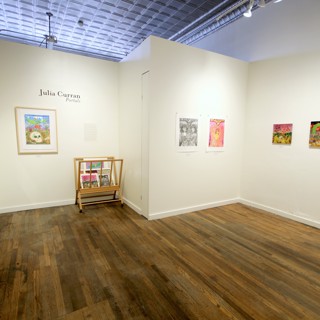Multidisciplinary artist Julia Curran poses these questions: “If soil is a metaphor of transformation, what of ourselves can be reborn if we allow our most destructive parts to break down into fertile mulch? What new gateways do we unlock when we embrace our fleshy, abject, and earthy truths?” Curran, a Midwestern artist currently based in LA, received her MFA in printmaking from Texas A&M University–Corpus Christi in 2015 and was a Fulbright scholar in Paris in 2011–12, and has since exhibited her work widely. Her recent work casts Mother Nature in dual roles: A mischievous propagator of decomposition and regeneration, and an opener of portals between worlds. Her style is grotesque, honest and humorous, drawing on historical memento mori paintings, anatomical prints and Hans Holbein’s Danse Macabre woodcuts. Like memento mori, they remind us that one day, even those of us “most inclined toward greed and cataclysm” will die. But in Curran’s work, death isn’t an ending—it’s merely a transitory point in the endless cycle of life, death, and rebirth.


She sees herself as a story-teller, and her inescapably physical work challenges societal illusions that the brain is separate from the body, and from the rest of the natural world. Her latest work holds up a mirror to the shadow-self, inviting us to examine “our relationship with our environment and with ourselves, and the mirrors we look into and portals we go through to find that,” Curran says. Her work in this show combines a breadth of techniques, including silkscreen, lithograph and monotype prints, as well as mixed-media collage paintings. Curran thinks of printmaking as a socio-politically conscious tradition: “...a way to disseminate knowledge through books and images, the rich history of hand printed protest posters, printmakers gathering around shared community presses and studios, and the nature of prints as editions, where artists can print multiple unique copies of a work that are more accessible to a wider audience in terms of both number and price point,” Curran says. Her work brings dark humor to the current catastrophic times, poking fun at human hubris in the face of the power of nature. “We’re living through what feels like a really precarious time, and I think we’re all feeling really unsettled,” Curran says, adding that her work blends humor with compassion: “Thinking about how we can give ourselves space and tenderness to embrace our vulnerability, and the things we’d prefer to keep buried.”
It’s an invitation to notice how the experience of her work registers in the body. “What I love the most is when someone really connects with my work both in terms of the dark humor and different cycles of transformation within their own lives, but also maybe about their own relationship with self, vulnerability, and interconnectedness.” Curran’s work is part of a dialog among many contemporary artists exploring themes of the underground and connections between body and nature. She references artist Kate Klingbeil’s recent work depicting imagery of nerves, blood vessels, and skin layers as landscape, documenting the artist’s experience with chronic illness and a broken medical system. Curran also points to Sasha Gordon’s surreal self-portraits, Heather Benjamin’s wild goddess drawings and sculptures, and Naudline Pierre’s goddess-like angel-guardian healer figures.
“I feel like there’s this amazing zeitgeist happening right now focusing on building mythologies and reimagining the world we want to see, and I’m excited to be a part of that conversation,” Curran says.
